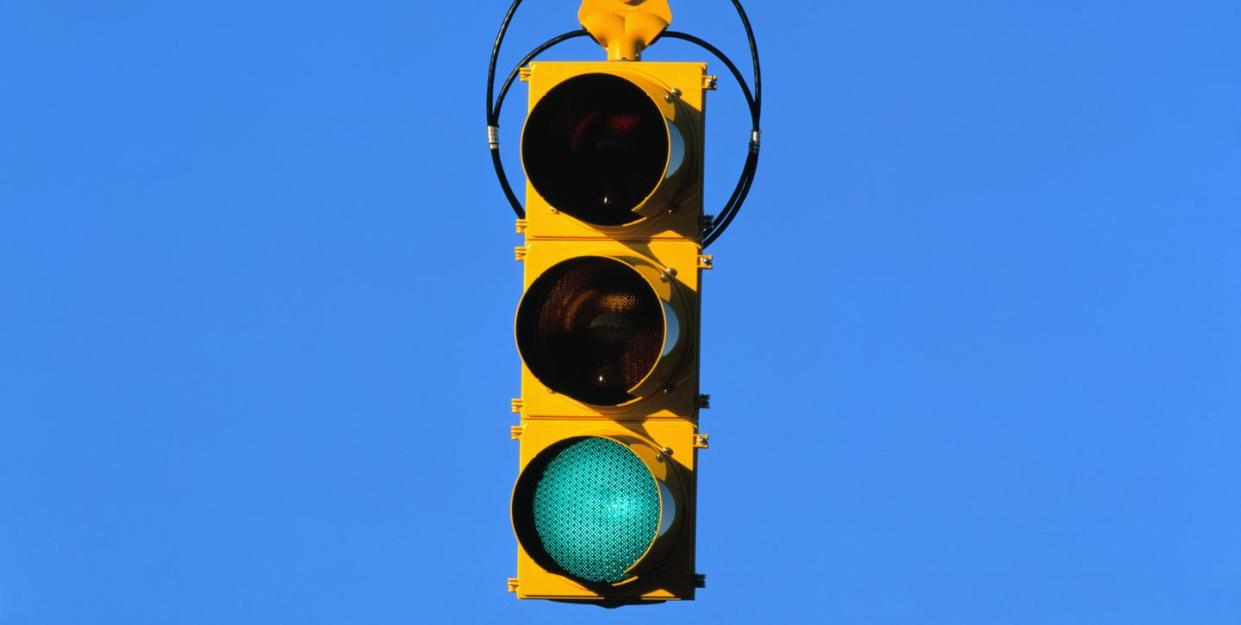A Study Proves Stoplights Need a Fourth Color: White

As more autonomous vehicles (AV) begin driving American roads, those roads need to change with them.
One research team proposes a white light that allows AVs to leverage their impressive networking capability.
These white light would signal human drivers to simply follow the car in front and could decrease traffic delays significantly
As more self-driving cars enter roadways around the world, many aspects of driving could change forever. More electric vehicles (EVs) and autonomous vehicles (AV) are already leading engineers to implement electric roadways and city planners to design dedicated lanes for AVs—and now, the humble traffic light is next for a makeover.
For the dawning age of the self-driving car, transportation engineers from North Carolina State University are proposing the addition of a fourth “white light” whose function would be to alert humans to simply “follow the car in front of them.”
That’s because to leverage the full potential of autonomous cars means to also embrace their ability to act as a kind of hive mind. Because they’re essentially computers on wheels, these cars can network with both the traffic light and other nearby self-driving cars to help ease traffic delays and increase fuel (or electricity) efficiency. The team’s results were published in the journal IEEE Transactions on Intelligent Transportation Systems on Monday.
“Granting some of the traffic flow control to the AVs is a relatively new idea, called the mobile control paradigm,” says corresponding author Ali Hajbabaie in a press release. “It can be used to coordinate traffic in any scenario involving AVs. But we think it is important to incorporate the white light concept at intersections because it tells human drivers what’s going on, so that they know what they are supposed to do as they approach the intersection.”
In this scenario, a traffic signal would operate as normal when the percentage of self-driving cars at an intersection is low, but when that number increases, the “white light” signals to human drivers that their robo-motorists have assumed control and to simply follow the car ahead. The paper’s authors say the light doesn’t need to be white and can be any color (we vote purple).
The researchers tested this system using microscopic traffic simulators, which are complex computational models designed specifically to recreate traffic conditions down to each individual car. When operating with the “white phase” intersection, traffic delays improved 3 percent when only 10 percent of cars were AVs—but that number jumped to 10.7 percent when there were 30 percent AVs. In other words, more AVs means less traffic.
The team first introduced the idea of a fourth light in 2020, but realized a centralized system with a traffic light receiving AV signals and calculating the best route caused processing delays. This made the concept impractical, so the researchers instead designed a more distributed system.
However, adding a new color to a traffic light is no easy feat—it’s sort of why it hasn’t been done in more than a century. There are hundreds of thousands of traffic lights in the U.S. alone, but 75 percent of those lights need to be upgraded or replaced. Those upgrades could (and should) prepare for AVs’ eventual arrival.
But instead of revolutionizing the four-way intersection near you, the authors say some near-term “white light” pilot programs could begin in a more controlled environment like ports where commercial vehicles, which are more likely to be AVs than personal vehicles, would benefit from an additional fourth light.
In the near term, things will remain red, yellow, and green, but this white light concept proves that AVs will one day upend every aspect of driving in the U.S. and throughout the world.
You Might Also Like

